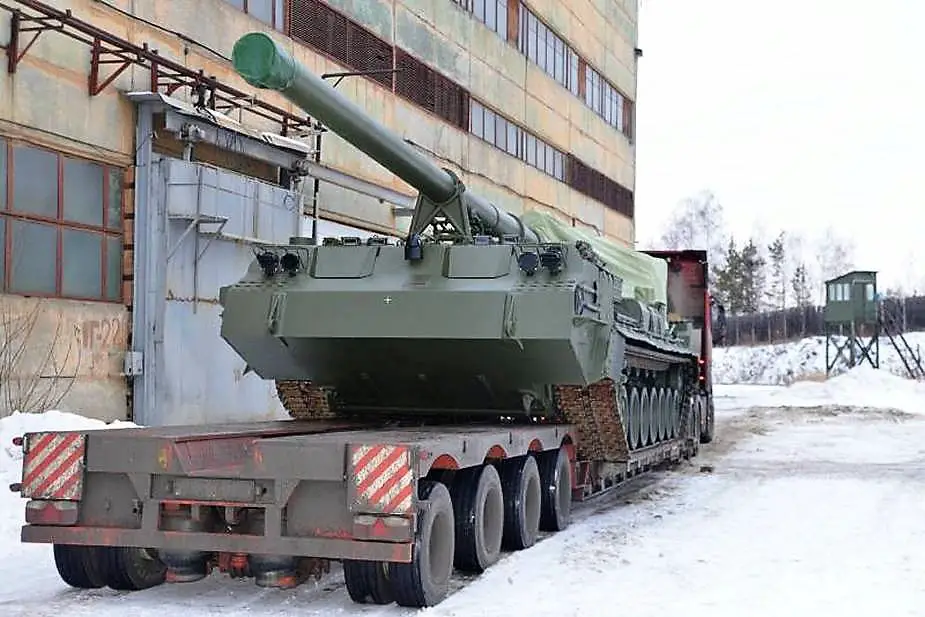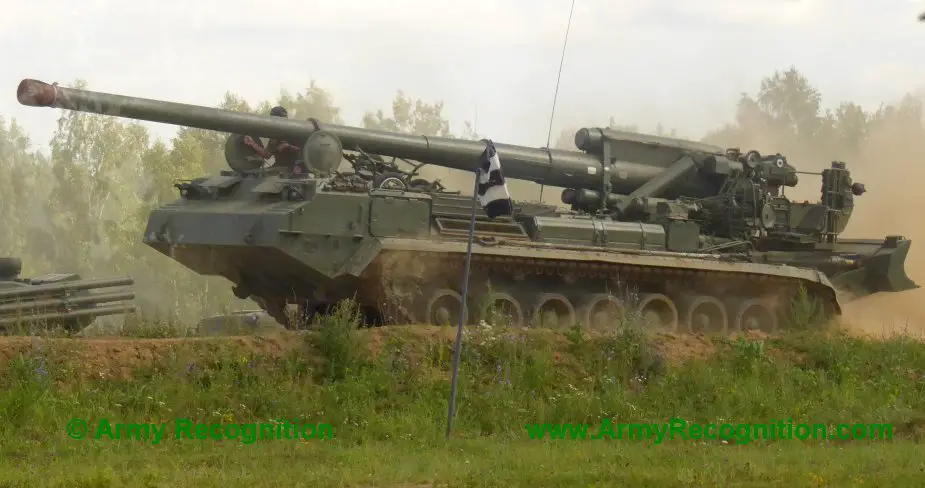Breaking news
Russian army receives first modernized 203mm 2S7M Malka self-propelled howitzers.
According to the press service of Uralvagonzavod, the first batch of modernized 2S7M Malka self-propelled howitzers was handed over to the Russian Ministry of Defense. the updated equipment has already been sent to the troops.
Follow Army Recognition on Google News at this link

Modernized 2S7M Malka self-propelled howitzer loaded for delivery (Picture source: topwar.ru)
The message does not contain information on the number of military equipment transferred to the army. It only notes that this is the first batch of 203-mm self-propelled guns 2S7M Malka, which have undergone a major overhaul with deep modernization within the framework of the state defense order. The modernization was carried out at Uraltransmash: replacement of the gearbox, distribution mechanisms, power supply units, observation devices and guidance system, intercom equipment and radio station. The CBRN protection system has been updated. Additionally, it is now possible to aim at a target using a UAV.
In April 2020, UVZ announced a deep modernization of the first ACS 2S7M Malka and readiness for serial modernization of the entire fleet of self-propelled guns. Apparently, the Ministry of Defense signed a corresponding contract with the company.
The 2S7M "Malka" with a 2A44 cannon of 203 mm is capable of firing various types of ammunition, including active-reactive and special ammunition with a nuclear warhead. Large-caliber self-propelled guns were once developed as a weapon for a possible tactical nuclear strike. The first modification - 2S7 "Pion" - has been in operation since 1975; the modernized version - 2S7M - since 1986.
The combat weight of the 2S7M "Malka" in the previous layout was 46.5 tons, the crew was 6 people, the radio equipment R-173 was standard, the ammunition carried was limited to 8 rounds, the self-propelled gun was brought into combat position within 7 minutes. As Rostec reported in 2020, new-generation shells are being developed for Malka.

2S7 Malka 203mm self-propelled howitzer displayed at Army 2018 near Kubinka (Picture source: Army Recognition)
2S7 Malka history
Technical requirements for the gun were drafted in March 1970 and the first serial Pion 2S7 guns were supplied to high-power artillery units in the second half of the 1970s. 2S7 has no turret and the gun is located at the back of the tracked undercarriage. The round of munitions includes breach-loading projectiles with variable charges. The main ones are high-explosive fragmentation and rocket-assisted projectiles. The former weighs 110 kg and contains 17.8 kg of explosives. The maximum range is 37.5 km and the initial speed is 960 m/sec. The latter projectile weighs 103 kg and contains 13.8 kg of explosives. The range is 47.5 km. The gun can also fire anti-concrete, nuclear and chemical shells. Over 500 2S7 guns of various modifications were produced in 16 years.
In 1983, 2S7 was upgraded into 2S7M Malka. The Military Balance said in 2018 the Russian high-power artillery was armed with 60 Malka guns.
Pion has never been engaged by the Soviet army in an armed conflict. The guns were mostly supplied to the Russian troops in East Germany. All Pion and Malka guns were redeployed back in Russia after the Conventional Forces Europe (CFE) Treaty was signed. The only known 2S7 engagement was in the war in South Ossetia where Georgia used a battery of six 2S7 guns. The Georgian troops hid all the six guns near Gori during its retreat. One of the five guns found by the Russian troops became a war booty and others were destroyed. There were reports about 2S7 engagement by the Ukrainian army in the southeast of the country, but no reliable confirmation was available.
"It is premature to speak about the end of barrel artillery which properly performed in the latest conflicts," expert Konstantin Makienko said.
The National Interest has recently reported an upgrade of Russian Tyulpan 2S4 mortars and Pion 2S7 howitzers. It said Russia was upgrading heavy artillery to integrate it into modern command and control systems and introduce modern communications and fire controls. The US publication cannot understand why Russia revived old weapons which it stocked after the end of the Cold War. One of the reasons may be a cheap production cost of shells for large-caliber artillery against missiles.
A high-ranking source in the missile and artillery forces told Gazeta.ru the engagement of high-power artillery with conventional shells is often more effective than the use of attack jets and bombers, specifically if it fires precision projectiles. The operation of artillery does not depend on weather and has a long-range and high precision.
The fire of high-power artillery is much cheaper than a combat aircraft sortie. High-power artillery is specifically effective in street fighting. "One point-blank shot of the 203mm gun can fully destroy a big house developed by the adversary into a stronghold. It helps motorized rifles fulfill missions without unjustified losses," he said.
As for similar weapons in the U.S. army, the 8-inch (203mm) M110 self-propelled howitzer was decommissioned in the 1990s, as the US military believed the effectiveness of large-caliber artillery was decreasing in modern conditions. The US 175mm M107 self-propelled gun was decommissioned in the late 1970s.

























